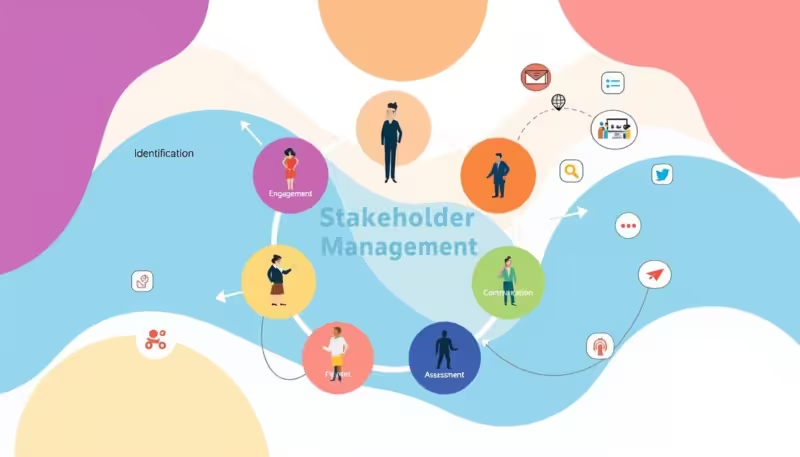Have you ever thought about how important a stakeholder’s view can be? It can really impact your project’s success.
Managing stakeholders isn’t just an extra part of planning a project. It’s key to making sure relationships work well and bring good results. Knowing how big of a role stakeholders have lets us understand that their involvement matters a lot. It can lower risks and help people work together better.
It’s very important to pinpoint who the stakeholders are early on. This helps avoid difficulties that can mess up your project. Clear talking from the beginning builds trust, which is super important. This means keeping stakeholders in the loop early and giving them chances to help make decisions. This approach helps with making changes easier to handle.
A surprising fact is that only 23% of stakeholders and project managers agree at the end of a project. This shows why it’s important to have strong stakeholder management in software development. It helps build relationships that last and makes sure everyone is listened to. By looking after what stakeholders need and expect, your project can have better communication. This helps everyone stay on the same page and leads to ongoing success.
Understanding the Importance of Stakeholder Relationships
Stakeholder relationships are key for any organization’s success. Both public and private groups see big impacts in their choices and project results. By building good relationships with stakeholders, an organization can lower project costs and improve decision acceptance.
Effective stakeholder engagement turns them into project supporters. This kind of teamwork is vital for making well-rounded decisions. It helps teams deal with risks and expectations better. Starting early and keeping in touch with stakeholders makes these relationships stronger.
- They make decisions faster and improve stakeholder relations.
- Projects face fewer delays and problems.
- It leads to better risk management and accountability.
- Trust and goodwill among stakeholders grow.
Prioritizing stakeholder engagement and clear management strategies helps firms strengthen ties. Knowing what stakeholders need and matching those to project aims can reduce risks. This also improves how a business operates.
The Key Components of Stakeholder Management
Stakeholder management is key for a project’s success. It starts with setting strategic objectives like lowering risks and boosting success. By identifying who has influence and how they’re involved, teams can create specific communication plans.
Strategic Objectives
When stakeholders know what they should do, it leads to better teamwork and trust. A good stakeholder management plan has a few important parts:
- A list of project stakeholders with basic information
- A stakeholder map or power-interest matrix
- Prioritization of stakeholders based on their influence
- A communication plan tailored to different stakeholder groups
Including stakeholders in important decisions promotes open dialogue and strengthens trust. Since stakeholders have different interests, analyzing them is a must. This analysis helps in communicating better, thus improving relationships essential for the project’s success.
Identifying Your Stakeholders
Knowing who your stakeholders are is vital for a project’s success. You start by making a list of people, groups, or organizations involved. This includes both internal and external parties. For internal, think about employees and project managers. For external, consider customers and suppliers.
Understanding these project stakeholders is crucial. It allows project managers to meet their needs and interests. This fosters a better project outcome.
Stakeholder mapping is a great way to see how stakeholders relate. It shows who has more influence or interest. With this info, managers can figure out who to focus on first. They use tools like the Power/Interest Grid. It helps categorize stakeholders into groups like “Manage closely” or “Keep Informed.”
In software development, improving stakeholder identification is key. It can involve using the project charter or management plans. The Salience Model is also helpful. It separates stakeholders based on power, urgency, and legitimacy. This approach helps understand stakeholder influence on the project.
Identifying stakeholders is more than making a list. It requires constantly checking their needs and role. This way, strategies can be tweaked as needed. Using stakeholders mapping and engaging with project stakeholders helps. It aids in overcoming issues when stakeholder goals clash, leading to success in the long run.
Conducting Stakeholder Analysis
Stakeholder analysis is key in project management. It looks at how different people affect or are interested in the project. It’s about figuring out what these folks need and expect. Dmytro Hurkovskyi notes that not all project managers take this step seriously. This can lead to missed opportunities for better engagement.
Starting stakeholder analysis early helps shape effective ways to interact. Projects change, so updating this analysis is crucial. Tools like the stakeholder power-interest matrix split people into four groups. This depends on their sway over and interest in the project:
- High influence and high interest
- High influence and low interest
- Low influence and high interest
- Low influence and low interest
Knowing these groups helps target communication. For example, backers or sponsors are key for planning. Meanwhile, regulatory bodies might have a big influence but less interest.
Doing a thorough stakeholder analysis helps teams meet expectations. It also spots how decisions could change the project. Dmytro suggests stakeholders should also do their analysis. This way, everyone is on the same page. It boosts project transparency and helps build a supportive community.
Putting Stakeholder Needs First
Addressing stakeholder needs is essential for effective relationships. It helps build trust and strengthen collaborations. By understanding and meeting these needs, organizations create goodwill and support.
Building strong relationships early leads to long-term collaboration. This makes loyalty grow and encourages stakeholders to help out. When they feel valued, they’re likely to support the project’s success.
Good stakeholder management boosts an organization’s reputation. It helps in getting project permits and navigating tough regulations. Making informed decisions involves understanding different viewpoints for balanced results.
Key figures like project sponsors, customers, and suppliers are vital for success. Engaging with stakeholders helps spot problems early, reducing risks. This keeps projects on track and sparks innovation in products and services.
Building Trust with Stakeholders
Trust is the foundation of strong relationships with stakeholders. Organizations that focus on building trust manage relationships better. They communicate well and are open about successes and setbacks.
Keeping people informed and being honest helps build credibility. This is key to gaining stakeholders’ trust.
Being accountable is also important in building trust. When organizations keep their promises, stakeholders feel valued and supported. They are more likely to support initiatives if they trust the organization. This is crucial when dealing with problems or new products. It leads to strong bonds, so stakeholders feel comfortable talking to Customer Success Managers (CSMs).
Adapting to different ways of communicating improves relationships. CSMs should talk to stakeholders at all levels, not just the top ones. This helps if a main contact leaves the project or organization. Knowing a lot about the clients’ fields also builds trust.
Being consistent in communication is very important. Organizations should understand and support what’s important to their customers. Allowing stakeholders to be part of decisions builds trust.
Trust is hard to build and easy to break. Keeping an eye on relationships and working to improve them maintains strong connections.
Encouraging Stakeholder Participation
Stakeholder participation is crucial for getting everyone on board with a project. By using smart engagement strategies, organizations can include stakeholders in making decisions. This can include methods like surveys and workshops to encourage discussions.
Letting stakeholders share their thoughts can steer a project in the right direction. It’s really important to keep in touch with those who have a big interest and influence. Listening to them shows that their goals matter too and helps avoid problems.
Tools like town hall meetings are great for getting many stakeholders together. This promotes working together as a team.
- Property owners: Engage early to ensure a smooth process.
- Local government agencies: Important for compliance and funding assistance.
- Developers: Insight into market conditions aids in crafting feasible visions.
- Community groups: Acts as the community’s voice and advocates for local interests.
- Financial groups: Critical for securing project financing.
- Environmental consultants: Partners in environmental assessments.
Using fair engagement methods is key, especially for helping disadvantaged groups. Tools like meetings, newsletters, and social media should match stakeholder needs. Inviting input early improves public image, builds trust, and solves issues.
Encouraging teamwork and talking throughout the project makes stakeholders happier. This approach is the backbone for long-lasting success and support.
Creating Alignment Among Stakeholders
Getting everyone on the same page is key for any group’s success. This includes company leaders, teams across functions, board members, and big customers during product creation. They help set plans and get products to market. Clear roles and goals help everyone work together better.
Building this teamwork starts with talking to stakeholders at different levels. Doing regular activities can strengthen this teamwork:
- Setting strategy: This involves top company leaders, the VP of product, the main product team, and major customers.
- Brainstorming new functionality: This process welcomes ideas from the product team, sales, support, and customers.
- Prioritizing ideas: This includes the VP of product, product team, engineering, finance, and customers working together.
- Planning the roadmap: The VP of product, product team, engineering, top customers, and key partners all take part.
Having regular meetings keeps everyone in sync. For example, reviewing the roadmap weekly and updating the whole team monthly helps. Celebrating wins and sharing updates keeps us all aiming at the same goals. Remember, explaining our strategy more than once helps ensure everyone gets it.
Leaders must be open to changing plans when needed. Recognizing the need to adjust keeps us nimble. Clear roles also help solve problems in complex organizations.
Using a product management tool designed for our needs improves teamwork. Making decisions based on customer feedback and data helps us understand each other better. Sasan Goodarzi, CEO of Intuit, says taking smart risks drives innovation. So, a culture of openness and shared goals is crucial for working well together.
Strategies for Effective Communication
Effective communication is key for stakeholder engagement and project success. It involves planned strategies to keep everyone updated and engaged. A strong engagement plan focuses on stakeholders’ needs for information frequency and clarity. Personalized messages build stronger relationships and trust.
Transparent communication is crucial for managing expectations and avoiding conflicts. Updating stakeholders on progress maintains commitment. This reduces misunderstandings or delays. Key messaging techniques include:
- Setting clear communication objectives to guide interactions.
- Documenting and tracking all communications to ensure continuity.
- Employing feedback loops to identify and address stakeholder concerns promptly.
- Tailoring communication styles based on stakeholder preferences.
- Establishing effective channels for ongoing dialogue.
Understanding the different interests and influence levels of stakeholders is important. It helps in creating a plan that speaks directly to their needs. Engaging stakeholders early helps project leads understand what they expect. This approach reduces resistance and boosts teamwork.
Regular updates and making documentation easy to access boost stakeholder confidence. Merging communication strategies with project planning is fundamental. It ensures everyone stays aligned as the project progresses.
Managing Stakeholder Conflict
Stakeholder conflict often happens in projects with many different stakeholders. Conflicts come up for many reasons. Sometimes, it’s because roles and tasks are not clear. Other times, it’s because people expect too much or want different things. Differences in how people communicate, their background, or their beliefs can also cause conflicts.
To handle stakeholder conflicts well, you need to use conflict resolution strategies. These strategies involve several steps:
- Identifying and analyzing root causes
- Prioritizing issues to focus on critical areas
- Collaborating with stakeholders for problem-solving
- Negotiating mutually beneficial solutions
- Defining win-win outcomes
Conflicts can come from many places, across all kinds of industries. Some conflicts are about goals or resources. Others might be about how a project affects the environment or transparency issues. These problems can cause expensive delays and affect the project badly, especially in Agile teams.
Project managers should make communication clear right from the start. It’s important to set and manage expectations throughout the project. Talking regularly helps solve problems and builds trust. Listening well helps you understand stakeholders better, leading to a successful project.
Using Stakeholder Relationship Management (SRM) software helps prevent conflicts. These tools keep track of stakeholder info, identify concerns early, and help communicate better. Handling feedback and complaints becomes easier, improving teamwork and leading to creative solutions.
When conflicts do happen, focusing on constructive solutions is key. Finding options and a clear plan helps solve conflicts. Sometimes, stakeholders might resist changes because they’re afraid of losing control. Being able to lead them through solutions effectively is very important. After solving conflicts, it’s best to keep moving forward and not dwell on past issues. Managing stakeholders well makes a project more likely to succeed by meeting everyone’s needs and expectations.
Utilizing Stakeholder Management Software Development
Stakeholder management software significantly boosts the process of engaging with stakeholders in projects. It offers a centralized place for all essential information. This makes it easy to keep an eye on changes in stakeholder views, their feedback, and their needs.
Using just basic tools like spreadsheets for this task can lead to mistakes and inefficiencies. Instead, stakeholder management software gives teams deep insights into stakeholder interactions. With these insights, teams can change their strategies when needed. This makes sure all engagements with stakeholders are fruitful.
By tracking relationships, project teams can understand what stakeholders want and how much they can influence the project. Teams use this information to create targeted communication plans. This approach builds a foundation of trust and respect, which is key for the success of any project and stakeholder happiness.
Furthermore, top software solutions in this area help in setting up regular feedback. This is very important in agile project management. With constant stakeholder feedback, it’s easier to guide the project in the right direction.
Project managers can keep everyone on the same page, reducing misunderstandings. This ensures that the project meets everyone’s expectations. In turn, teams can deliver results that not only achieve project objectives but also increase stakeholder support for the project.
Monitoring and Evaluating Stakeholder Relationships
Watching and assessing relationship monitoring is key to changing plans as situations shift. Checking how well we connect with stakeholders often helps organizations. They use surveys, feedback, and how well things are going to do this.
Recording every interaction with stakeholders lets us update our strategies quickly. For example, big building projects have many stakeholders like local government, environmental groups, and local people. Keeping them in the loop with regular updates and meetings is crucial. It makes sure everyone feels listened to and important, improving how we all work together.
In areas like software making, groups like the developers, bosses, investors, and users need to know what’s happening. Setting clear goals helps keep track of how engagements are doing. This way, companies can see what’s working well and what isn’t.
Hearing out concerns and suggestions from stakeholders is very important for strong connections. Having a good system to manage stakeholder relationships helps organizations keep an eye on engagements. By looking at the data, businesses can make better communication plans. This leads to happier stakeholders and more trust.
Conclusion
In summary, managing people who have a stake in your project is key to success. It doesn’t matter how big your organization is. Startups need to build strong relationships because of their tight budgets and clear goals. Big companies, though, have more resources. Yet, they face challenges that can slow them down. Still, they gain from having organized methods and wide networks.
Building strong relationships with stakeholders is a continuous process, not a one-time thing. It’s about keeping in touch, checking in, and being ready to change plans when needed. This helps turn interactions into lasting partnerships. It’s important to look after the main players like employees, customers, and investors. And not forget others like the media and groups that advocate for certain causes. This way, companies can face challenges better.
Success comes from knowing the different situations. Whether you’re in a fast-moving startup or a big, structured corporation. It’s crucial to communicate well. This brings everyone’s interests and views together. Doing this improves your project and sets the stage for future ones. With this approach, businesses can build strong, enduring relationships. This supports their goals in the long run.






